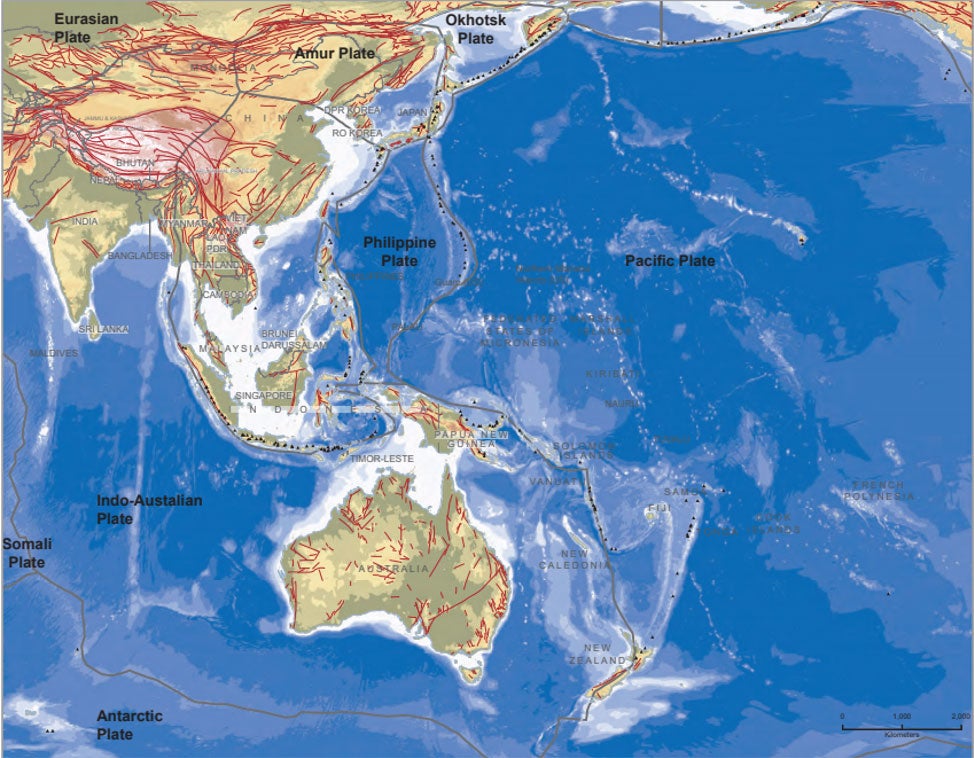Moody's RMS earthquake risk models help manage complex and varied seismic risk across Asian countries with a history of significant loss events.
Asia Earthquake Risk
Earthquake risk in Asia is extremely varied and depends on the tectonic setting within each individual country. The highest hazard regions are either underlain by subduction zones, including Indonesia, the Philippines, Japan, Guam, and New Zealand, or along collision plate boundaries such as northern India and southwestern China. Lower seismic risk is generally located away from the tectonic plate boundaries, including Australia, Thailand, Vietnam, South Korea, southeastern China, and southern India, but some regions have a significant component of plate motion on complex active fault systems, including China, Taiwan, Japan, Sulawesi (Indonesia), and New Zealand.
The tectonics for Asia are fairly complex and driven by the collision of the Pacific and Philippine Plates with the Eurasia and Indo-Australia Plates. In general, the Pacific Plate is pushed beneath the other plates, producing major subduction zones from Japan to Guam to New Zealand. The Philippine Plates are subducted beneath Japan and the Philippines.
Australia is located away from the outer boundaries of the Indo-Australian Plate, leading to lower levels of seismicity. The Indo-Australian Plate is subducted beneath Indonesia where it collides with the Eurasian Plate in Northern India, producing the Himalayas. The largest events in the historical earthquake record are generally along plate boundaries with a few additional events occurring on major crustal fault systems.
Significant Events
Asia has a long history of strong, damaging earthquakes and tsunamis. Future events in Asia have the potential to impact insurers' profitability in this important emerging market.
- The 2004 M9.1 Andaman-Sumatra, Indonesia, event off the western coast of Sumatra triggered tsunami waves to a height of 30 meters and killed an estimated 230,000 people across 14 countries and caused extensive devastation in Indonesia and Sri Lanka.
- An M7.6 event in Kashmir, India/Pakistan, during 2005 caused an estimated 100,000 deaths and rendered 3.5 million people homeless in northern Pakistan and Pakistan-administered Kashmir.
- In Wenchuan, central China, an M7.9 event in 2008 was felt as far as Shanghai, 1,700 kilometers away, triggering extensive landslides and claiming approximately 70,000 lives.
- The Canterbury Earthquake Sequence in New Zealand (2010 M7.2 Darfield; 2011 M6.2 Lyttelton) centered around the city of Christchurch and saw a sequence of events that destroyed 15,000 homes and losses of around $23 billion.
- In 2011, an M9.0 earthquake and tsunami centered on Tohoku, Japan, saw waves up to 40 meters high with over 100,000 buildings totally destroyed and many more damaged. Insured losses reached over $30 billion.
Moody's RMS Solutions
Moody's RMS offers a comprehensive earthquake model suite with coverage across Asia which includes Japan, South Korea, China, Taiwan, Hong Kong, Macau, the Philippines, Guam, Indonesia, Thailand, Vietnam, Malaysia, Singapore, India, Australia, and New Zealand. To reflect the latest understanding of earthquake hazards, building performance, and risk in the region, the majority of these models were updated in the last few years. The model suite provides a consistent framework for modeling loss across a range of scales, from location to portfolio, within a city or across country borders. These solutions can be used to build deep insight into the full range of risk. Companies can use these Moody's RMS models to develop pricing structures that reflect the locations at risk.
Tectonic setting and seismicity for Asia


Find the Model to Fit Your Needs



